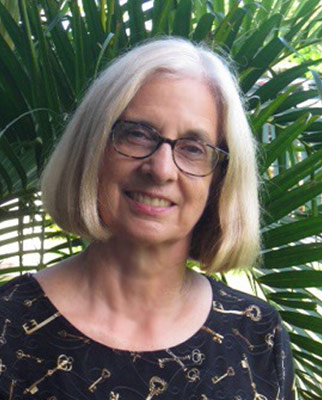The IPM Toolbox: "Planting Wildflowers for Pollinator Habitat" – Webinar Recording

Cathy Neal, Extension Professor & Landscape Horticulture Specialist, UNH Coop. Extension; Researcher, New Hampshire Agricultural Experiment Station, University of New Hampshire
Recorded September 18, 2018.
Cathy Neal, Extension Professor & Landscape Horticulture Specialist, UNH Coop. Extension; Researcher, New Hampshire Agricultural Experiment Station, University of New Hampshire
This presentation is for anyone who wants to create gardens or wildflower meadows to enhance pollinator habitat and provide season-long floral resources for bees. Cathy will discuss seed mixes and plant selection, site preparation, planting, and maintenance requirements. Learn to “think like a bee” while adding beauty and diversity to your landscape. The first three years require effort and patience, but you will be rewarded as your meadow matures into a self-sustaining system. The results of bee monitoring studies to determine which perennial species (and, in some cases, cultivars) are most visited by bees may surprise you.
About the Presenter
Cathy Neal works with the landscape and nursery industry to develop and conduct educational programs that enhance the environment and provide ecosystem services. Pollinator habitat, biodiversity and water quality protection are areas of current emphasis in outreach programs and in teaching Sustainable Landscape Design and Management. Investigating best techniques for establishing meadow gardens using native grasses and wildflowers—this project aims to help property owners/landscapers turn excess lawn areas or weedy areas into low-maintenance meadows that provide habitat for birds and pollinators and provide storm water infiltration areas with minimal inputs. She is a founding member of the Northern New England Pollinator Habitat Working Group. Her expertise is in the selection, planting and establishment practices for landscapes using native grasses and wildflowers for creating sustainable pollinator habitats.
Download presentation slides (PDF, 28 MB)
Questions and Answers
Quickly jump to a question and answer in the Q&A segment of the video by using the links provided below.
Establishment
- My yard is overgrown with “weeds,” somewhat intentionally, as I have seen they attract many insects so I just leave them be. However, I want to have as fully a native garden as possible, and I also want to tidy up the yard a bit without removing native plants. Do “weeds” tend to be native?
A: https://youtu.be/jJOux7xn40s?t=4718
- Is there a “decision tool” on the web to help make place-based planting decisions?
A: https://youtu.be/jJOux7xn40s?t=4809
- Are there any examples where these plantings are established adjacent to agricultural fields; if yes what is the best design for supporting pollinators and other beneficials in terms of natural enemies of the pest species?
A: https://youtu.be/jJOux7xn40s?t=4889
- Are there any programs available that provide incentives or other support to promote establishment of such natural ecosystems to sustain pollinators in larger scale?
A: https://youtu.be/jJOux7xn40s?t=5020
- Do you have thoughts on using species native to a local region under 100–200 miles, versus a larger native area of several states.
A: https://youtu.be/jJOux7xn40s?t=5077
- What can I start doing now, since I’ve already missed this year’s growing season?
A: https://youtu.be/jJOux7xn40s?t=5196
- Should fall seeding ideally be done after a hard frost?
A: https://youtu.be/jJOux7xn40s?t=5237
- How is climate change affecting pollinators, is it documented, and what is being done to mitigate some of the impact?
A: https://youtu.be/jJOux7xn40s?t=5308
Management
- Do you have to mow the meadow after it’s established or can you leave it alone?
A: https://youtu.be/jJOux7xn40s?t=5372
- About 20 years ago, I converted a little over an acre of lawn around my house into a wildlife habitat. About 6 years ago, I created a wildflower meadow that covered about 20% of that. Bees, wasps, butterflies, etc., appeared in large numbers. It was beautiful. The bats were very happy, too. Since then, the wildflower meadow has reverted to the usual weeds that thrive in Pennsylvania where I live. I need to restart the cycle. Unfortunately, we are being invaded by stilt grass. It is spreading fast and taking over the landscape. I missed the deadline for cutting it down before the grass seed reaches maturity in August. What advice can you offer? I’m thinking about sowing buckwheat as it may have a chance to successfully compete with the stiltgrass—but I’m not convinced that will work.
A: https://youtu.be/jJOux7xn40s?t=5426
- We planted a meadow 6 years ago and the native golden rod took over and has crowded out almost all other plants. We know we need to start over and don’t want to make the same mistakes so are there other plants to avoid?
A: https://youtu.be/jJOux7xn40s?t=5533
- What is your recommended strategy for dealing with invasives in the meadow?
A: https://youtu.be/jJOux7xn40s?t=5720
- How do you manage woody encroachment on an established meadow?
A: https://youtu.be/jJOux7xn40s?t=5810
- Do I need to worry about deer damage?
A: https://youtu.be/jJOux7xn40s?t=5828
- How do you manage aphids on milkweed?
A: https://youtu.be/jJOux7xn40s?t=5894
